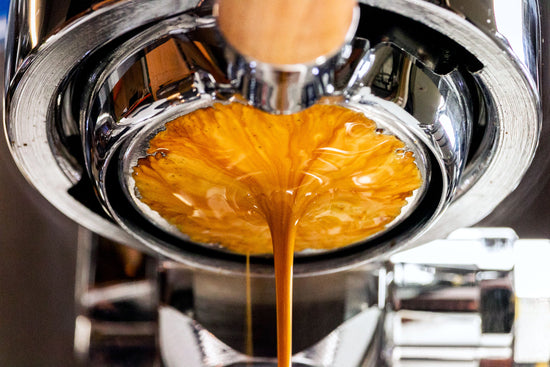Espresso Channeling - What Is It?

Channeling is something that we, like many in the coffee industry, talk about very frequently. We try to avoid it but, unless you know the culprits, that can be difficult. So let’s go over what it is, why it’s so bad, how to spot it, and most importantly how to avoid it.
So what is channeling? In short, it’s when water finds a specific narrow path through the puck of coffee instead of flowing through the entire bed evenly. To help visualize it, let’s induce some channeling in a shot. After grinding and distributing our coffee, we’ll simply press this pick through the coffee and against the screen to create a little channel. When we tamp, that hole seems to disappear – but when we pull the shot, you can see that the first drops to come through the filter are from the exact spot where we created our channel.
Throughout the shot, this specific path will have a much greater flow rate than the rest of the puck. This means the grounds in that path will have more soluble materials extracted from them than the rest of the puck and contribute unbalanced flavors to our final shot.
This leads us to why channeling is so bad: it ruins the clarity of flavor in your espresso. If you haven’t already, I recommend watching our video on extraction, as it’ll help you understand what makes channeling so frustrating. In an ideal world, the entire volume of the puck would see about the same amount of water throughout the shot. This would mean that every particle has the same amount of soluble material extracted. Since channeling causes some areas to flow more and some to get less, it throws off our extraction by over and under-extracting different areas of the shot. The result is a shot with muddied, unclear flavors.
So how can you tell if your shot is experiencing channeling? First, you’ll want to use a bottomless portafilter. There are a few warning signs to look out for, and they’re easiest to identify by looking at the underside of your portafilter basket. As we showed earlier, watching how the first drops of espresso flow from the bottom of your portafilter is a great way to see how evenly water moves through the puck. You shouldn’t hold your breath for a perfectly flat distribution of drops, but if you see a clear preference for one area versus another, you may have an issue.
After the first drops have fallen and a steady flow of espresso is coming through the filter, the thing to look for is gaps. Ideally, we want to see almost none of the metal filter showing through that pretty crema waterfall. While areas of channeling will get plenty of flow, the areas surrounding the channel will get less. You’ll see spots on the filter where no espresso appears to be coming through. This is another sure sign of channeling.
The last sign is the most dramatic and the messiest when using a bottomless portafilter. Some instances of channeling can cause a tiny (or not-so-tiny) jet of water to shoot from the underside of the filter. If you’re lucky, this ends up in the drip tray and not on your shirt. While this is clearly the most dramatic display of channeling, that doesn’t necessarily mean it represents intense channeling.
Now that we know how to spot channeling, what can we do to mitigate or fully avoid it? First, we can ensure that we’re using a solid recipe. Working with coffee that’s ground too fine can often result in an increased channeling rate, likely due to the strong resistance posed by the denser areas of the puck. You can ensure you're not making things harder on yourself by ensuring your shots are pulled at a ratio between 1:1 and 1:2.5 and in a timeframe between 20-35 seconds.
Next up is distribution, a topic that deserves a video of its own. The more evenly we distribute our coffee in the portafilter basket, the less likely we are to see channeling. Distribution begins the moment you start grinding. Every grinder dispenses grounds into the basket differently – some deliver a relatively even spread without interference, while others may favor a certain region or be overly focused. Regardless, we like to help the grind out by moving our portafilter in small circles to ensure that coffee is spread evenly across the surface of the basket.
Last but not least, we’ll talk about distribution tools and tampers. Tools like the Saint Anthony Industries wedge can work wonders by gently spreading the grounds evenly across the entire surface of the basket. Since we started stocking them, almost everyone in our offices will go out of their way to find one before tamping. When it comes to tamping, we want to make sure we’re as level as possible. Any tilt to one side or the other will result in one half of the puck being more resistant to flow than the other, causing the water to favor the less resistant side. If you’re using a traditional tamper, ensure that you’re using the proper technique and double-check that your tamper looks level in the basket afterward. We highly recommend Saint Anthony Industries depth-calibrated tampers if you’re looking for a foolproof way to ensure a level tamp. They sit on the basket's rim to ensure your tamp is perfectly level every time.